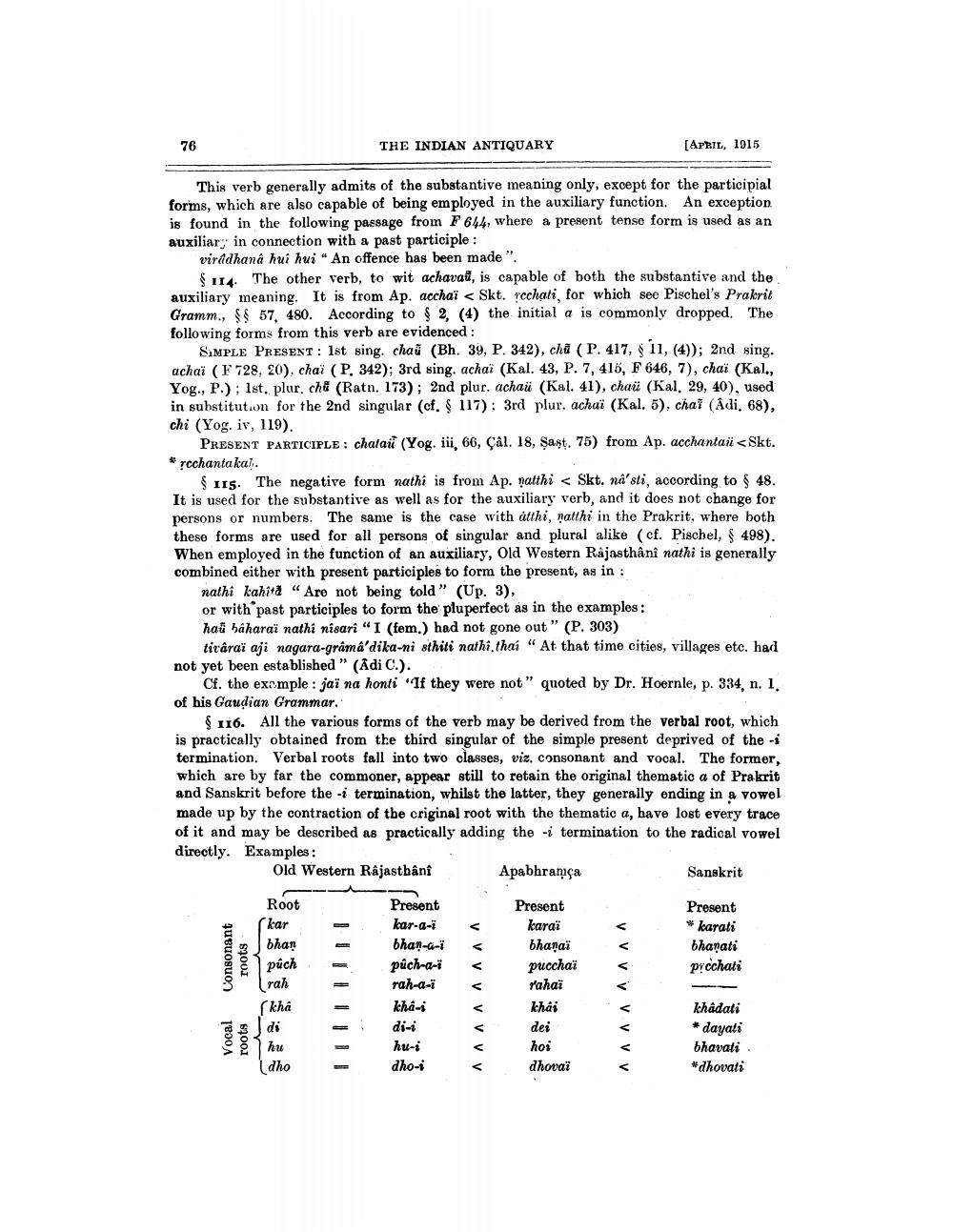________________
76
THE INDIAN ANTIQUARY
[APRIL, 2015
This verb generally admits of the substantive meaning only, except for the participial forms, which are also capable of being employed in the auxiliary function. An exception is found in the following passage from F 644, where a present tense form is used as an auxiliary in connection with a past participle :
viradhana hui hui "An offence has been made".
$14. The other verb, to wit achavai, is capable of both the substantive and the auxiliary meaning. It is from Ap. acchaï < Skt. rcchali, for which see Pischel's Prakrit Gramm., $$ 57, 480. According to $ 2, (4) the initial a is commonly dropped. The following forms from this verb are evidenced :
SIMPLE PRESENT : 1st sing. chau (Bh. 39, P. 342), chủ (P. 417, 11, (4)); 2nd sing. achaï (F 728, 20), chaï (P. 342); 3rd sing. achaï (Kal. 43, P. 7, 415, F 646, 7), chai (Kal., Yog., P.); 1st. plur, chi (Ratn. 173) ; 2nd plur. achai (Kal. 41), chaü (Kal. 29, 40), used in substitution for the 2nd singular (cf. § 117): 3rd plur. achaï (Kal. 5), chal (Ådi. 68), chi (Yog. iv, 119).
PRESENT PARTICIPLE: chatait (Yog. iii, 66, Çal. 18, Şast. 75) from Ap. acchantai <Skt. * rcchantakal.
$ 115. The negative form nathi is from Ap. natthi < Skt. na sli, according to $48. It is used for the substantive as well as for the auxiliary verb, and it does not change for persons or numbers. The same is the case with atthi, natthi in the Prakrit, where both these forms are used for all persons of singular and plural alike (cf. Pischel, $ 498). When employed in the function of an auxiliary, Old Western Rajasthani nathi is generally combined either with present participles to form the present, as in:
nathi kahită “Are not being told " (Up. 3), or with past participles to form the pluperfect as in the examples: hau baharaï nathi nisari " I (fem.) had not gone out " (P. 303)
tiraraï aji nagara-grâmâ'dika-ni sthiti nathi.thai "At that time cities, villages etc. had not yet been established " (Adi C.).
Cf. the example: jaž na honti "If they were not " quoted by Dr. Hoernle, p. 334, n. 1. of his Gaudian Grammar.
$116. All the various forms of the verb may be derived from the verbal root, which is practically obtained from the third singular of the simple present deprived of the - termination. Verbal roots fall into two classes, viz. consonant and vocal. The former, which are by far the commoner, appear still to retain the original thematic a of Prakrit and Sanskrit before the -i termination, whilst the latter, they generally ending in a vowel made up by the contraction of the criginal root with the thematic a, have lost every trace of it and may be described as practically adding the -i termination to the radical vowel directly. Examples: Old Western Rajasthani Apabhramça
Sanskrit
Root
Skar
bhan
V V
V
Consonant
roots
Present * karati bhanati pecchati
púch
V
Present karaz bhanaä pucchai rahai khai dei
V
Present kar-a-7 bhan-a-7 pach-a-i rah-a-7 khadi-i hu-i dho-1
(rah
V
V
V
Vocal roots
V V
V V V
khadati * dayati bhavati *dhovati
hoi
V
dhovač
V




